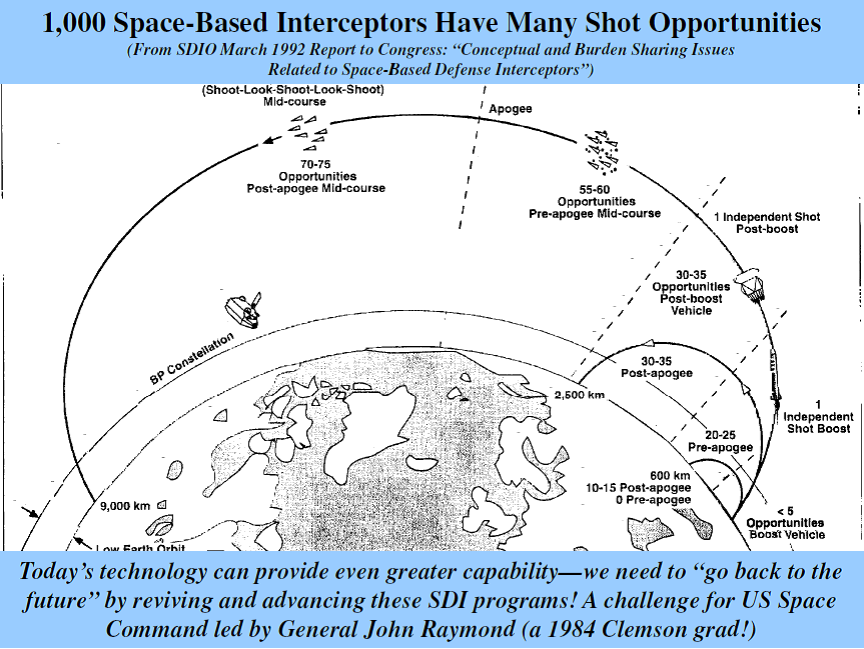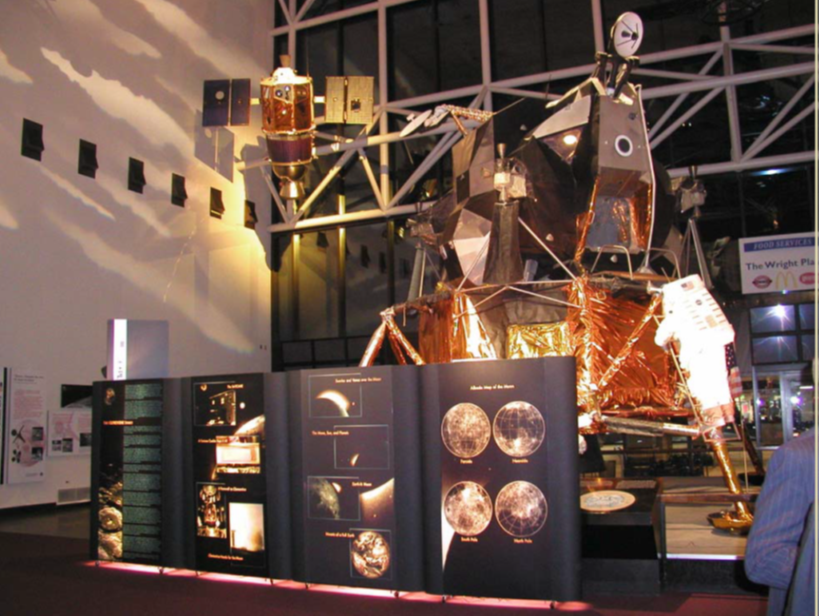The first four Directors of what is now the Missile Defense Agency believed we knew how to build a cost-effective space-based interceptor system called Brilliant Pebbles 30 years ago. Moreover, Brilliant Pebbles became the first product of President Ronald Reagan’s Strategic Defense Initiative (SDI) to enter a formal Demonstration and Validation program, approved in 1990 by the Pentagon’s top acquisition executive. The fully vetted by the Pentagon cost estimators, in conjunction with outside expert critical reviews, estimated the cost for development, deployment and operations of 1000 space based interceptors for 20 years to be $20 billion in today’s dollars. We need to “go back to the future!” with today’s more advanced technology which should lead to lower costs.
Just before leaving for its 11-day Memorial Day recess, the Senate Armed Services Committee (SASC) passed the John S. McCain National Defense Authorization Act for 2019, including 30 important amendments proposed by Senator Ted Cruz (R-TX).
Click here for those amendments including the most important one that directs the Defense Department to “develop a space-based intercept (SBI) layer, which can take out missiles when they are most vulnerable, during the boost phase.” Moreover, the SASC recommended ample funds to begin this important boost-phase intercept (BPI) effort.
Assuming these provisions survive the Senate-House Conference, there should be no legal or technical hurdle to deploying this needed protection quickly and inexpensively.
The legal problems were dismissed in 2002 when President George W. Bush withdrew from the Anti-Ballistic Missile (ABM) Treaty that banned “testing, development and deployment” of space, air, sea and mobile land-based ABM systems; and 30-years ago we learned how to build space-based defenses, the most cost-effective global defense to intercept ballistic missiles in their boost-phase.
We called that system “Brilliant Pebbles.” It was a constellation of numerous, small, light-weight satellites guided by on-board super-capable light-weight sensors and computers to maneuver into the path of on-coming ballistic missiles beginning in their boost-phase, and throughout the remainder of their flight until they reinterred into the atmosphere on their final approach to their targets.
Every “Brilliant Pebble” knew where neighboring Pebbles were, determined whether it had the best “shot” at a given target, and if so informed the rest of the constellation and took the shot. The main command decision was to engage the constellation and let the constellation do the rest, while overseeing and if needed terminating the subsequent battle. If such autonomous operation seems bizarre, consider that today the private sector is contemplating self-driving automobiles on our crowded highways and streets.
The basic idea was conceived by physicists and engineers at Lawrence Livermore National Laboratories (LNRL) during the watch of the first SDI Director, USAF Lt. General James A. Abrahamson. General Abrahamson’s End of Tour report called out Brilliant Pebbles as among his top priorities, if not his top priority, for moving into a formal Defense Acquisition Board (DAB) Demonstration and Validation (DemVal) phase. His successor, USAF Lt. General George Monahan led formal initiation of that DemVal program, which I inherited as the third SDI Director.
That assignment followed my role as President Ronald Reagan Chief Negotiator with the Soviet Union at the Defense and Space Talks in Geneva primarily charged with defending his SDI in those negotiations. As the Cold War was winding down (prompted in a major way by highly visible SDI progress), Congress was severely cutting back on Defense Department spending across the board, and in particularly SDI funding.
In late 1989, President Bush ordered an independent review of the SDI program and the related negotiations with the Russians, shortly after I had passed my Chief Negotiator baton to Ambassador Dave Smith. Defense Secretary Dick Cheney then asked me to lead that review and recommend next steps.
Because I concurred with the first two SDI Directors on the importance of Brilliant Pebbles, it became a key component of the Global Protection Against Limited Strikes (GPALS) architecture that I recommended to Secretary Cheney and President Bush.
GPALS moved away from the goal of deterring a large scale Soviet attack on the U.S. homeland to protecting against a limited attack from anywhere on not only the U.S. homeland but also our overseas troops, friends and allies. For example, our objective was to kill all of 200 nuclear armed reentry vehicles launched from a submarine off our shores. Following my March 1990 report, President Bush concurred with my recommendation, and Secretary Cheney asked me to lead the SDI and “make it happen.”
Most important for today’s message is that the NDAA approach recently recommended by Senator Cruz is what was followed for the Brilliant Pebbles activities initiated by General Abrahamson and continued by USAF Lt. General George Monahan, the next SDI Director. General Monahan formed a Brilliant Pebbles Task Force, reporting directly to him, to manage that effort, because the U.S. Air Force had shown little interest in the LLNL technology innovation and was blocking rapid progress.
That Brilliant Pebbles Task Force contracted with several companies competing during a rapid Concept Definition Phase, and down-selected to two companies for a DAB-approved DemVal Phase. I inherited that approved program and incorporated it into my GPALS effort in June 1990, which became the focus on my SDI watch until January 1993.
My watch began shortly before Saddam Hussein invaded Kuwait in August 1990, during which the perception of the contribution of Patriot in that conflict gave a welcome boost to our missile defense efforts — particularly for what became known as the Theater Missile Defense (TMD) component of GPALS.
Because of its role as a TMD system, we were also able to initiate the Navy’s Aegis ballistic missile defense (BMD) program, which has since gained significant global capability — and if fully enabled also can provide a significant homeland defense capability.
In addition to the TMD component, there was a National Missile Defense (NMD) ground-based interceptor homeland defense component and the space-based Brilliant Pebbles global component, which could defend against attacks on our overseas troops, friends and allies as well as on our homeland.
See below for a descriptive chart illustrating the capabilities of that Brilliant Pebbles system, from a figure from an important March 1992 report to congress describing the Brilliant Pebbles system and the other GPALS components. And click here for the full report.
When fully vetted by the Pentagon cost estimators in 1989, in conjunction with outside expert critical reviews, the cost for development, deployment and operations for 20 years was estimated to be $10 billion in 1988 dollars, corresponding to $20 billion in today’s dollars.
Current technology, already being exploited by our private sector — as well as potential adversaries, e.g., Russia and China — should reduce significantly those quite affordable costs. For example, click here for a report last summer describing how a Soyuz 2-1A rocket launched from Baikonur cosmodrome in Kazakhstan, placed into orbit an imaging satellite and 72 micro-satellites. Reportedly, all satellites successfully separated and were released into three different orbits; and “For the first time in the world, such a complex and large mission has been developed and implemented.”
The primary payload, the Kanopus-V-IK satellite, reportedly was to provide wide-angle images of the Earth (allegedly to be used to detect forest fires or to update the topography of maps) — and the 72 small satellites included those made by Japan, Germany and Canada along with 62 U.S. nanosatellites known as CubeSats.
Notably, China also has for years been developing such small satellites, aided by technology passed to them through a British firm, Surrey Satellite Technology Ltd (SSTL), as discussed in Appendix B of the 2007 and 2009 reports by the Independent Working Group (IWG) on Missile Defense, the Space Relationship and the Twenty-First Century. Click here for the 2009 IWG report and consider two introductory paragraphs that may encourage you to read the entire Appendix, beginning on page B-7:
“The Surrey Satellite Technology Ltd (SSTL) webpage1 claims with some justification that SSTL is the world’s leading pioneer of small satellite applications and technology. Over the past two decades, SSTL and its University of Surrey partner have produced reliable high-quality small satellites at significantly lower costs by adapting advanced, commercial-off-the-shelf (COTS) technologies for the harsher conditions of space, precisely the approach followed in the late 1980s by Lawrence Livermore National Laboratory’s Brilliant Pebbles program. But, while the United States abandoned Brilliant Pebbles, Surrey excelled in developing and refining this innovative approach to innovative manufacturing and operations of small satellites.
“SSTL and its staff of under 100 professionals and technicians, introduced modular microsatellite design in 1990, delivered its first usable remote sensing imagery from a 50 kg satellite in 1991; first demonstrated in 1993 on-board orbit determination using GPS along with a star camera and an advanced earth imaging system; and during the past twenty-three years has launched twenty-three small satellites into orbit for international customers as diverse as the United States Air Force and the Chinese Tsinghua University. Roughly half of SSTL’s customers purchase know-how along with their satellites, and the other half opt for turnkey services.”
Thus, the IWG was concerned in 2007 and 2009 about China’s advances dating from the early 1990s, even while the U.S. Defense Department dropped its efforts to exploit U.S. Commercial Off-the-Shelf (COTS) technology to develop space-based interceptor (SBI) ballistic missile defense (BMD) systems. In particular, the Brilliant Pebbles effort, pursued by the Strategic Defense Initiative (SDI), pioneered these activities to demonstrate much more capable nanosat technology than then were being considered by other Pentagon advanced technology programs.
Had the Democrat-controlled Congress permitted that “Brilliant Pebbles” effort to continue on my watch as SDI Director (ending on January 20, 1993), I believe we could have demonstrated the viability of a much more capable missile defense capability than any we have today, and for much less money than we have spent on our ground-based homeland defense.
But congress was then devoted to the Anti-Ballistic Missile (ABM) Treaty, which banned “testing, development and deployment” of space-, air-, sea- and mobile-land-based ABM systems. (Note this constraint would have blocked our Aegis missile defense efforts if given a homeland defense capability.) Never mind that our approved DemVal program employed Treaty-compliant technology demonstrations that could prove the viability of the Brilliant Pebbles space-based interceptor concept — consistent with President Reagan’s SDI vision.
Moreover, SDI opponents opposed efforts to “weaponize” space, as was their mantra. Never mind that the intended target ballistic missiles traversing space had crossed that line during World War II. I well understood this political obstacle from my involvement in leading the Reagan administration’s successful effort to overcome congressional attempts to block testing of the USAF F-15 anti-satellite (ASAT) system.
The Soviet Union incorporated an understanding of this political resistance into its arms control positions that we countered for five years in Geneva. The Soviets sought to ban so-called “space-strike arms” — defined to include ASATs and all ABM systems except those permitted by the ABM Treaty — most notably ground-based ABM systems such as their operational system.
SDI — and especially its space-based defense focus — was targeted by the Soviets, as made clear when President Reagan walked out of the Reykjavik Summit after Gorbachev demanded we limit testing of space-based defenses to the laboratory. By the early 1990s, we had successfully resisted the Soviets and the Soviet Union dissolved. But congress still opposed any SDI effort to support building a space-based defense system — and blocked our efforts to demonstrate the value of such systems.
Specifically on my watch, Congress directed us to remove Brilliant Pebbles from its fully Pentagon-approved DemVal status and severely cut the president’s budget requests. And congressional hearings signaled that, if President George H.W. Bush were re-elected, the Democrat controlled congress would starve even that limited Brilliant Pebbles effort.
As it turned out, President Bush was not re-elected and President Clinton’s Defense Secretary and former Chairman of the House Armed Services Committee Les Aspin, as he said, “took the stars out of Star Wars.” His directives completely scuttled all Brilliant Pebbles research and sharply curtailed all other SDI efforts, including TMD which it claimed as a top priority.
This redirection reflected opposition to any threat to the 1972 Anti-ballistic missile (ABM) Treaty as the “cornerstone of strategic stability” — a phrase referring to the Cold War’s Mutual Assured Destruction (MAD) mutual suicide pact between the Soviet Union and the United States.
Then USA Lt General Malcolm O’Neill, who had been involved in the early SDI efforts and was my Deputy Director, became Director of the renamed SDI program — the Ballistic Missile Defense Organization. He had the task of picking up the pieces after the Clinton administration gutted the SDI program, especially the Brilliant Pebbles effort — as the Defense Secretary memorably claimed, they “took the stars out of Star Wars.”
Mal did not welcome this development, but had no choice but to try to pick up the pieces. Nevertheless, he joins the first three SDI Directors in judging that Brilliant Pebbles was the most cost-effective defense concept developed during the SDI era (1983-93). Click here for a May 11, 2018 Newsmax article making this point explicitly.
The ABM Treaty permitted research (to include technology demonstrations) on space, sea, air, and mobile land based defenses of the U.S. homeland, but congress as a whole never bought into conducting such unrestricted research, and at least a residual opposition still currently exists.
Finally, I want to note that we actually demonstrated the key technology needed to develop and deploy Brilliant Pebbles by the mid-1990s—in spite of the dedicated opposition of congressional Democrats and the Clinton administration. Because of the negative feedback I got from congress in 1992 hearings, I sought an alternate way that could achieve political support to demonstrate that key technology.
The upshot became known as the “Clementine” mission to return to the Moon for the first time in a quarter century, to map its surface, and then to “sling-shot” back by Earth into deep space and be “lost and gone forever” — per that ballad, “Oh My Darling, Clementine.”
The Naval Research Laboratories (NRL) led the Clementine system integration effort employing sensors and system mission command systems scavenged from Livermore National Laboratories’ theoretical and experimental explorations that led to Brilliant Pebbles. (LLNL had also supported the SDI effort to down-select to two competing DemVal contractor teams.)
We collaborated with NASA, and especially then NASA Administrator Dan Goldin (who led the Brilliant Pebbles effort at TRW — one of the two 1990 DemVal contractor teams). NASA launched the Clementine payload into space and it exceeded my hopes in space-qualifying all key Brilliant Pebbles sensor and operating command systems — and recording about 1.5 million frames of data in 13 spectral bands.
At a cost of about $80-million, Clementine achieved more information on the Moon’s surface than the entire Apollo program and discovered water in its polar regions — confirmed by subsequent NASA missions. The small Clementine team received awards from NASA and the National Academy of Sciences, and a replica hangs in the Smithsonian next to NASA’s Lunar Lander. See upper left below.
A follow-on mission was supported by Congress, but President Clinton vetoed that legislation because of its exploitation of SDI technology. Such was the abiding hostility to Ronald Reagan’s key initiative that among other things is credited with a major role in “ending the Cold War without firing a shot.”
Bottom Lines
Hopefully, we are beyond such political inhibitions. But forgive my hesitation in believing that is true.
At least Senator Cruz has the right idea. Hopefully, President Trump and his team will exploit his lead. But I must note John M. Donnelly’s Roll Call article opposing Senator Cruz’s initiative. It is filled with flawed logic and incorrect information.
Click here for that Roll Call article, and click here for my Newsmax article for an opposing view.
The Pentagon’s Missile Defense Review report to congress is due shortly, and it will tell the tale.
What can you do?
Join us in praying for our nation, and for a rebirth of the freedom sought, achieved and passed to us by those who came before us.
Help us to spread our message to the grass roots and to encourage all “powers that be” to provide for the common defense as they are sworn to do.
Begin by passing this message to your friends and suggest they visit our webpage www.highfrontier.org, for more information. Also, please encourage your sphere of influence to sign up for our weekly e-newsletter.
Encourage them to review our past email messages, posted on www.highfrontier.org, to learn about many details related to the existential manmade and natural EMP threats and how we can protect America against them. I hope you will help us with our urgently needed efforts, which I will be discussing in future messages.
Click here to make a tax deductible gift. If you prefer to mail a check, Please send it High Frontier, 20 F Street 7th Floor, Washington, DC 20001.
E-Mail Message 180612
Please click here to read Past Weekly Updates!
Please help High Frontier continue this important and timely work!
Be sure to follow us on our Social Sites!
If you found this letter via our Social Sites, and you would like to subscribe, please click below!







